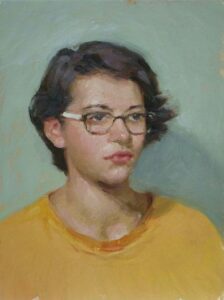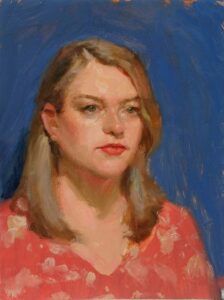Three years ago I wrote a blog about things I’ve learned over the last thirty years as an artist. These are things we may have heard in school or elsewhere, but, like Dorothy Gale, perhaps we may have just had to ‘learn it for ourselves’’.
Since then a few more thoughts have bubbled up.
1. It’s Hard
Nothing new here. I start every workshop by saying ‘painting is hard’. I love the Tom Hanks ‘it’s hard’ scene from A League Of Their Own when he states, “It’s supposed to be hard. If it wasn’t hard everyone would do it”.
2. It’s All Work
I used to stress about time away from the easel. Travel, shipping, framing, corresponding, photographing work and getting it out there, going to galleries and museums, visiting artist friend’s studios.… these things used to make me feel like time was being wasted. Then I had the glorious revelation that it’s all work.
This mishmash is what makes us artists, so just do these things well and enjoy each one. Hopefully with this acceptance comes a winnowing process to realize what it takes to be the most effective artist we can be. I have read that Norman Rockwell painted virtually every day, even Christmas. How he amassed such a deep level of human interest and understanding is beyond me. Genius is the likely explanation. We mortals have to actually take the time to interact, be places, see things, and get to the easel as much as we can.
3. Craft vs. Emotion
As we learn, it is natural to be proud of our skills, and push to develop them more. Think of a pianist who can fly through scales. The thing is, that is not very interesting to anyone!
To stay with the music analogy, a heartfelt Moonlight Sonata or Rhapsody In Blue or Let It Be can bring us to tears. Not because of craft. Because of emotion.
For people to deeply relate to our work they need an emotional connection along with skill. Of course each of us has to find that balance. No one is interested in a Moonlight Sonata with stops and starts and off notes and such (unless it is a near relative playing). Here the analogy slips. Note the strong interest in Folk Art, where the artists have little or no training. In painting, sometimes emotion connects more than craft.
Craft is important. And with visual art I do think people are impressed with great skill. But the greatest work finds a way for viewers to connect on an emotional level. That could be joy, serenity, shared interest, sorrow, passion… whatever. This is ‘unity’ and it can be sensed in any art form in a nanosecond. To see this in action, watch Susan Boyle singing the song from Les Miserables on Britain’s Got Talent.
Since then a few more thoughts have bubbled up.
1. It’s Hard
Nothing new here. I start every workshop by saying ‘painting is hard’. I love the Tom Hanks ‘it’s hard’ scene from A League Of Their Own when he states, “It’s supposed to be hard. If it wasn’t hard everyone would do it”.
2. It’s All Work
I used to stress about time away from the easel. Travel, shipping, framing, corresponding, photographing work and getting it out there, going to galleries and museums, visiting artist friend’s studios.… these things used to make me feel like time was being wasted. Then I had the glorious revelation that it’s all work.
This mishmash is what makes us artists, so just do these things well and enjoy each one. Hopefully with this acceptance comes a winnowing process to realize what it takes to be the most effective artist we can be. I have read that Norman Rockwell painted virtually every day, even Christmas. How he amassed such a deep level of human interest and understanding is beyond me. Genius is the likely explanation. We mortals have to actually take the time to interact, be places, see things, and get to the easel as much as we can.
3. Craft vs. Emotion
As we learn, it is natural to be proud of our skills, and push to develop them more. Think of a pianist who can fly through scales. The thing is, that is not very interesting to anyone!
To stay with the music analogy, a heartfelt Moonlight Sonata or Rhapsody In Blue or Let It Be can bring us to tears. Not because of craft. Because of emotion.
For people to deeply relate to our work they need an emotional connection along with skill. Of course each of us has to find that balance. No one is interested in a Moonlight Sonata with stops and starts and off notes and such (unless it is a near relative playing). Here the analogy slips. Note the strong interest in Folk Art, where the artists have little or no training. In painting, sometimes emotion connects more than craft.
Craft is important. And with visual art I do think people are impressed with great skill. But the greatest work finds a way for viewers to connect on an emotional level. That could be joy, serenity, shared interest, sorrow, passion… whatever. This is ‘unity’ and it can be sensed in any art form in a nanosecond. To see this in action, watch Susan Boyle singing the song from Les Miserables on Britain’s Got Talent.
4. A Weekly Painting Group Rocks!
Ok, this is not new information either. I have been in groups like this on and off since the ‘80s. But if you had told me when we started nearly four years ago that our Wednesday Night Head Study Sessions would have so many benefits I would have been skeptical.
We paint a different sitter for three hours each week, and our skills have improved, our travel kits (a must!) are complete, we’ve grown so close, met so many interesting people of all ages and backgrounds, discussed so many things… I could go on. This, in a town of 1700 people, in a county of 20,000. You may have more than that in your neighborhood! So please, just do it! Paint from life with friends once a week, whether it’s portrait, still life, or landscape.
You can read more on our group and some practical tips on getting started here.
Ok, this is not new information either. I have been in groups like this on and off since the ‘80s. But if you had told me when we started nearly four years ago that our Wednesday Night Head Study Sessions would have so many benefits I would have been skeptical.
We paint a different sitter for three hours each week, and our skills have improved, our travel kits (a must!) are complete, we’ve grown so close, met so many interesting people of all ages and backgrounds, discussed so many things… I could go on. This, in a town of 1700 people, in a county of 20,000. You may have more than that in your neighborhood! So please, just do it! Paint from life with friends once a week, whether it’s portrait, still life, or landscape.
You can read more on our group and some practical tips on getting started here.
by Richard Nelson
by Richard Nelson
by Richard Nelson
5. Travel Kit
So often as a teaching artist one sees folks who either don’t have a travel kit or can’t set the dang thing up. If you have not done so, do yourself a favor and get a ‘rig’; everything you need to paint in the field, classroom, give a demo, whatever.
Mine is a traditional French easel (Creative Mark Safari 2, around $100) slightly modified so I can stand or occasionally sit, a palette, odorless mineral spirits, viva paper towels, an artist’s umbrella, and large tubes of the paint. This is always in my car, with a great LED light and stand, which works with rechargeable batteries or plugs in.
Happy painting, and may we all keep learning and growing each day we’re lucky enough to be artists!
PS- You can read the first installment of Stuff I Wish Someone Had Told Me here.
Mine is a traditional French easel (Creative Mark Safari 2, around $100) slightly modified so I can stand or occasionally sit, a palette, odorless mineral spirits, viva paper towels, an artist’s umbrella, and large tubes of the paint. This is always in my car, with a great LED light and stand, which works with rechargeable batteries or plugs in.
Happy painting, and may we all keep learning and growing each day we’re lucky enough to be artists!
PS- You can read the first installment of Stuff I Wish Someone Had Told Me here.




Leave a Reply